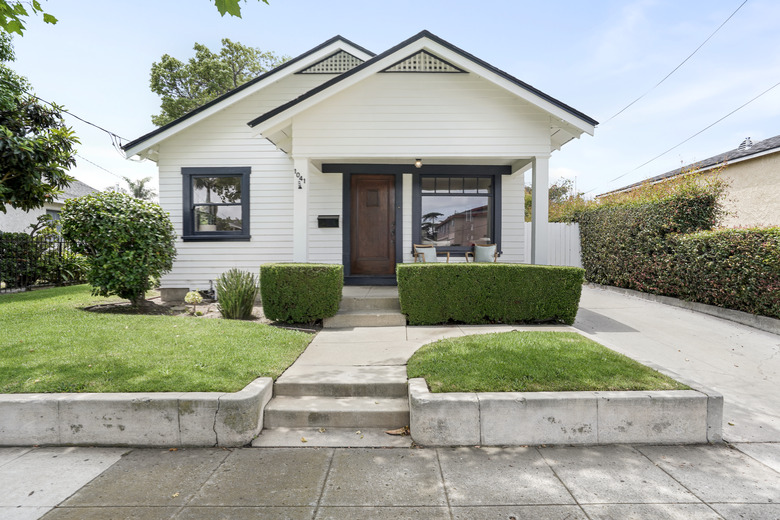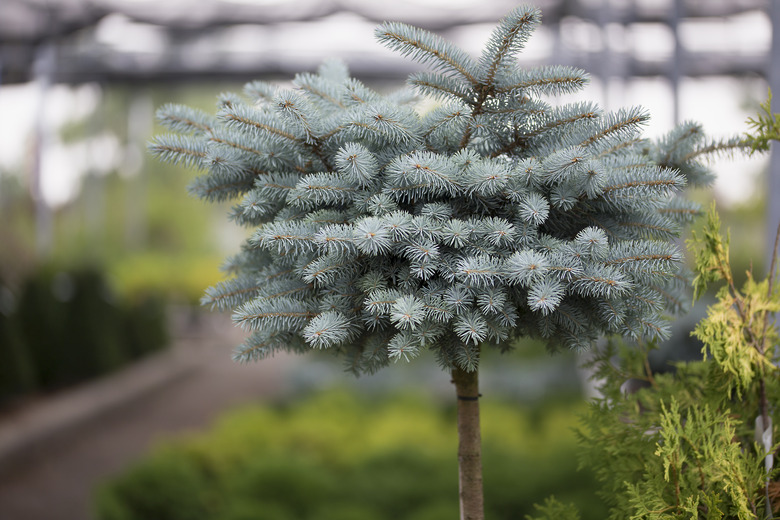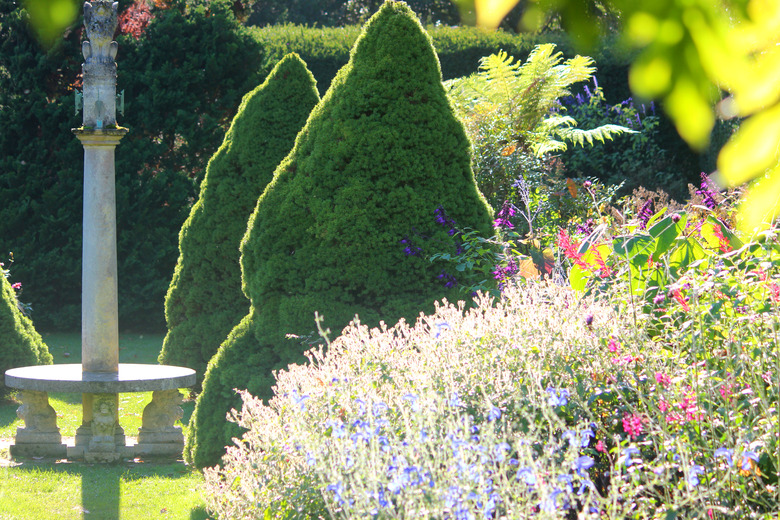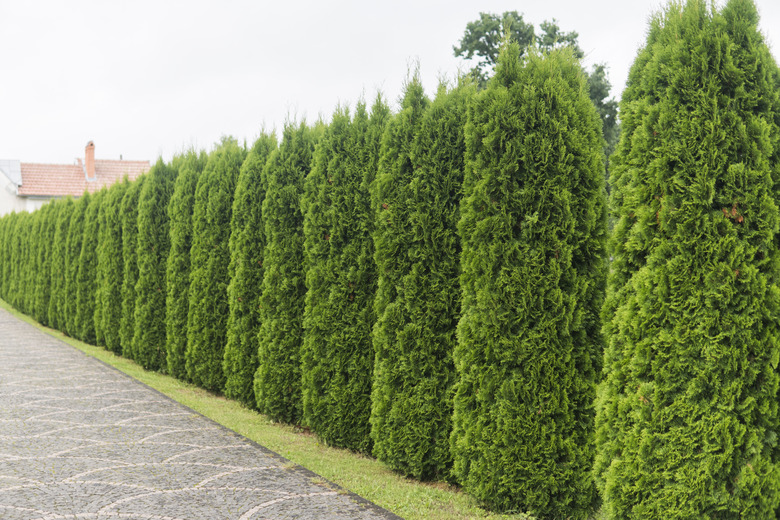10 Best Small Evergreen Shrubs For Your Landscape
We may receive a commission on purchases made from links.
If you want a bit of color in your lawn or garden all year, evergreen plants make excellent choices. If you're working with a small space, however, it's best to stick with small evergreen shrubs. Tall pine trees may overwhelm the space and interfere with power lines and other overhead obstacles. Fortunately, there are many attractive evergreens that remain a manageable size at maturity and are low maintenance for gardeners.
Dwarf Globe Blue Spruce
Dwarf Globe Blue Spruce
Known as (Picea pungens 'Glauca Globosa,' USDA zones 2-7) among botanists, the dwarf globe blue spruce is an excellent choice for smaller landscapes. The shrub's needles keep their attractive blue hue all year long but turn particularly vivid in the summer months. This summer pop of blue is attractive on its own but adds an interesting contrast to summer garden beds.
Gardeners and landscapers sometimes use this spruce as a small hedge or an anchor in island flower beds where year-round color is desired. You can also grow the dwarf globe blue spruce in a container. The trick to properly using this shrub is to avoid getting too fancy or colorful around it. The bright-blue needles speak for themselves and allow this plant to shine even when it's planted alone.
Because the dwarf globe blue spruce is winter-hardy to zone 2, it's an option for a large number of American gardeners. When planted in full or partial sun, this slow-growing shrub will eventually grow to a height of 3 to 5 feet and a width of about 6 feet. It stays rounded as it grows, so you need not worry about trimming or special care. All this species needs from you is a weekly watering.
Compact Maximum Rhododendron
Compact Maximum Rhododendron
The compact rosebay rhododendron (Rhododendron maximum 'Compacta,' USDA zones 3-9) is a bushy plant that works well as a foundation planting or border shrub. Group plantings also work well. The leaves of this attractive plant keep their deep-green color all year, but you'll get a beautiful pop of pink or purple flowers late in the spring.
Hardy to -40 degrees Fahrenheit, the compact rhododendron needs very little care. Plant the rhododendron in full to partial sun where there is well-drained, acidic soil. This shrub will go without if necessary, but Monrovia suggests feeding rhododendrons with an acidic fertilizer after they bloom. This will make for a healthier and more robust plant.
Winter Creeper
Winter Creeper
Winter creeper (Euonymus fortunei, USDA zones 4-9) is a beautiful evergreen, but it's a bit of a double-edged sword. This plant grows just about anywhere and is very easy to care for—however, creeper grows quite quickly, and can easily sprawl out or grow into a vine. When grown as a shrub, winter creeper grows only 3 to 4 feet tall and 4 to 5 feet wide, but you'll need to keep an eye on your plant and do some trimming and shaping if you want to maintain your winter creeper as a shrub. Note, too, that winter creeper is considered invasive in some places, so check with your local cooperative extension service before planting it.
Winter creeper grows in full sun or full shade. The plant's evergreen leaves are tinged with yellow or white depending on the variety, and this hardy plant will tolerate dry soil and withstand occasional droughts. If you do decide that winter creeper will work for you, use it as a foundation planting or grow it in a large container.
Kelsey's Dwarf Red-Osier Dogwood
Kelsey's Dwarf Red-Osier Dogwood
Technically, this dogwood is a deciduous plant. You can't truly call it evergreen, but you could absolutely call it the perfect addition to your garden that is in desperate need of some color throughout the year. Kelsey's dwarf red-osier dogwood shrubs (Cornus sericea 'Kelseyi,' USDA zones 2-8) are green in the summer, produce white flowers in the spring and turn a deep shade of red in the winter. These red winter stems will be bare and devoid of leaves, but the stunning color more than makes up for the temporary lack of foliage.
When mature, the dwarf red-osier dogwood creates a rounded shrub that is 2 or 3 feet high and wide. This shrub likes full or partial sun. You can use these plants as foundation plantings or create a border with them. They're also frequently planted on hillsides to help stop erosion and can serve as natural hedges.
You'll want to water your dogwood about once a week during its first year, but it will tolerate both drought conditions and wet feet once established. For the best winter color, hard prune one-third of the plant's oldest stems annually in late winter. This will stimulate new, brighter red growth.
Tiny Tower Dwarf Alberta Spruce
Tiny Tower Dwarf Alberta Spruce
Grown in USDA zones 3 through 8, the Tiny Tower® dwarf Alberta spruce (Picea glauca var. conica 'MonRon') is an absolutely charming evergreen shrub. Reaching 6 feet in height and growing in a perfect pyramid shape, these quaint trees create the look of a well-maintained topiary garden without any of the work.
As long as it receives full to partial sun, this tiny Alberta spruce can serve as a hedge, create a border or stand within a mass planting. It will also grow in containers, allowing you to flank your front door or add color to your patio. These compact conifers reach only 4 to 6 feet in height and measure approximately 2 feet around.
Monrovia suggests spacing your plants a few inches away from one another or any structures, as the tiny tower Alberta spruce does need good air circulation. You can prune the tree as needed to maintain its pyramid shape, but this will require only light and periodic attention.
Scallywag Holly Shrub
Scallywag Holly Shrub
It may have an odd name, but Scallywag™ holly (Ilex x meserveae 'Monnieves') is a tough little plant that grows readily in USDA hardiness zones 5 through 9. This slow grower takes a few years to reach its mature size of 4 feet wide and 3 feet tall and is highly adaptable to a wide array of soils. Like most small evergreen shrubs, this holly requires regular watering during its first year to establish a deep root system.
Scallywag holly requires full sun but little else. After the first year, your holly plant will need little attention. You can prune holly to create a tidier and more sculpted appearance, but doing so isn't necessary. The white spring flowers and purple-hued winter leaves look good anywhere but work especially well as hedges and foundation plants.
Blueberry Delight Juniper
Blueberry Delight Juniper
If you're looking for a small evergreen shrub that can fill in garden bare spots or serve as a ground cover, look no further than the blueberry delight juniper (Juniperus communis var. depressa 'AmiDak' BLUEBERRY DELIGHT, USDA zones 2-6). Although it reaches only 8 to 12 inches in height, this wide juniper will grow 4 to 5 feet in diameter.
Juniper needs full sun to thrive but will tolerate most soils, even if it's rocky. It copes with both hot and cold weather very well. Wet feet are a no-no, however, and won't be forgiven as easily as poor soil or drought.
You'll find that each one of your juniper's grayish-green needles contains a single blue stripe down the middle for an interesting two-tone effect. In the fall and winter, these needles will turn a coppery color. The blueberry delight juniper will sprout blueberry-like fruits in the cooler months that will attract birds to your garden. Deer and rabbits, however, generally leave juniper alone.
Cream De Mint Dwarf Pittosporum
Cream De Mint Dwarf Pittosporum
If you live in USDA plant hardiness zones 8 through 11, you're fortunate to reside where the Cream de Mint™ dwarf pittosporum (Pittosporum tobira 'Shima') grows as a perennial. The mint-green leaves on this small evergreen shrub are tipped in white and look great all year. Spring brings small white flowers to the plant as well for added visual interest.
Cream de Mint pittosporum makes an excellent informal hedge, but like juniper, it can also fill in garden bare spots. It's an excellent choice for firescaping, which is the act of choosing plants that resist fire and can help keep wildfires away from homes and businesses.
This pittosporum species grows in a mounded shape, reaching only about 2 feet high and 2 feet wide. If they appear unshapely, you can prune your pittosporum shrubs every winter to keep them tidy. You'll also need to water your plants weekly during dry spells and fertilize them in the spring as new growth begins to appear.
Arborvitae Evergreen Shrubs and Hedges
Arborvitae Evergreen Shrubs and Hedges
Arborvitaes (Thuja spp.) are extremely popular with American gardeners, and it's easy to see why. These shrubs require very little care and have beautiful evergreen leaves that come in many different hues. One of the more popular cultivars is the dwarf golden arborvitae (Thuja orientalis 'Aurea Nana,' USDA zones 6-9), which keeps its attractive greenish-gold color all year.
Dwarf golden arborvitaes reach heights of 4 to 6 feet and grow to be 3 to 5 feet wide. They make excellent hedges and keep their conical shape well without trimming or pruning. Dwarf golden arborvitaes require full or partial sun and like well-drained soil.
The Fire Chief™ globe arborvitae (Thuja occidentalis 'Congabe,' USDA zones 5-8) is another arborvitae cultivar worth considering. Like the dwarf golden arborvitae, the fire chief globe arborvitae grows into a pleasing round shape without any trimming or pruning. This small evergreen shrub boasts bright golden and red leaves during the fall and winter.
This slow grower will reach a mature height of 2 feet, but it will take about 10 years to get there. Mature fire chief globe arborvitaes reach a diameter of about 4 feet. These plants make nice low hedges and work very well in rock gardens. You can also use them as border plants.
Camellias Hedges and Border Plants
Camellias Hedges and Border Plants
Like other evergreen species, camellias (Camellia spp.) keep their leaves all year. What makes these plants special is their stunning flowers, which blossom from fall to spring, providing colorful flowers when most other plants don't. If you mix and match early-blooming camellias with later-blooming varieties, you can have white, pink, lavender, red and yellow flowers in your garden from October through May.
Thanks to hardy new hybrids, camellias are now enjoyed in USDA hardiness zones 6 through 9. Reaching up to 12 feet in height and 5 to 10 feet in width, camellias make excellent hedges and border plants. They'll also grow in containers and work anywhere you want a pop of color. They do need partial sun to shade.
Plan your camellia placement carefully, as these plants don't like to be moved once established. Camellias also require protection from wind and a very routine watering schedule. They don't adapt well to change.
References
- Monrovia: Dwarf Globe Blue Spruce
- Monrovia: Compact Rosebay Rhododendron
- Savvy Gardening: Compact and Small Evergreen Shrubs
- The Morton Arboretum: Wintercreeper
- Country Living: 20 Essential Evergreen Shrubs for a Gorgeous Garden Year-Round
- Monrovia: Kelsey's Dwarf Red-Osier Dogwood
- Monrovia: Tiny Tower Dwarf Alberta Spruce
- Monrovia: Scallywag Holly
- Missouri Botanical Garden: Juniperus Communis var. Depressa
- Birds & Blooms: 9 Tiny Evergreens to Grow Year-Round
- Monrovia: Cream De Mint Dwarf Pittosporum
- Monrovia: Fire Chief Globe Arborvitae
- Monrovia: Dwarf Golden Arborvitae
- Gardenia: Camellias
- Missouri Botanical Garden: Camellia Japonica



